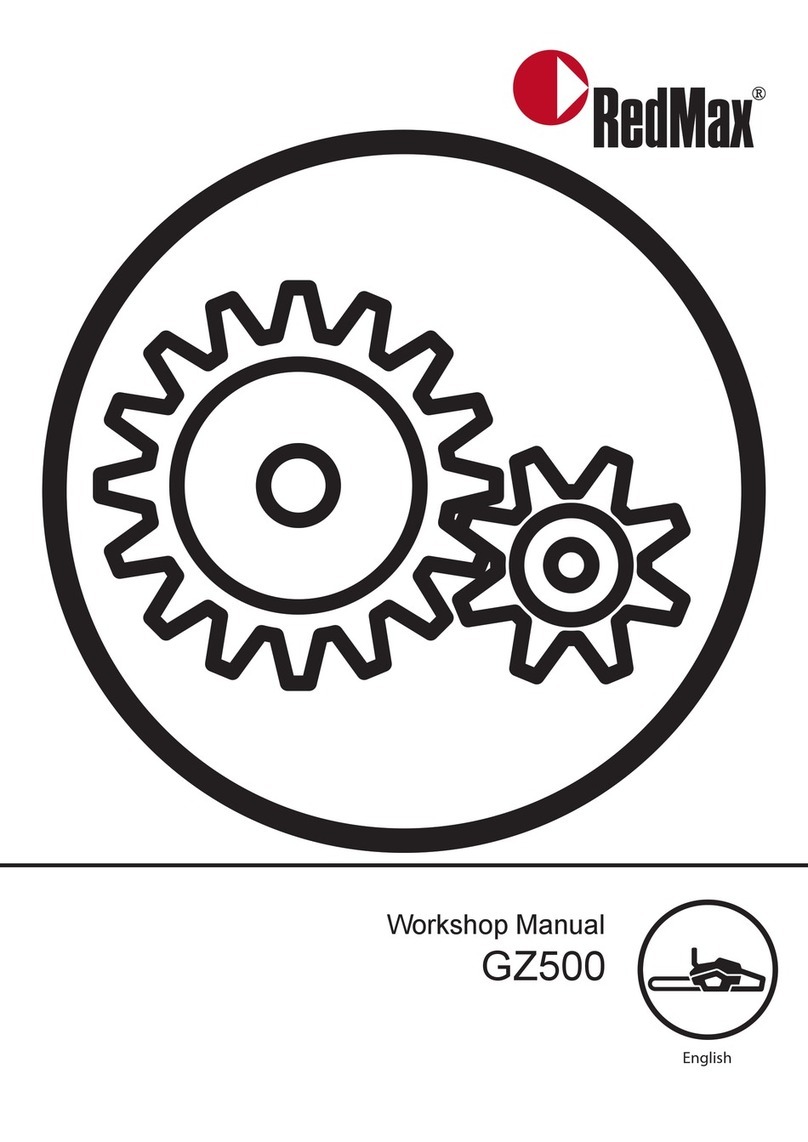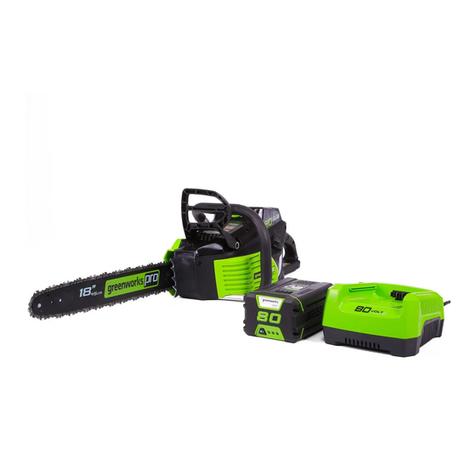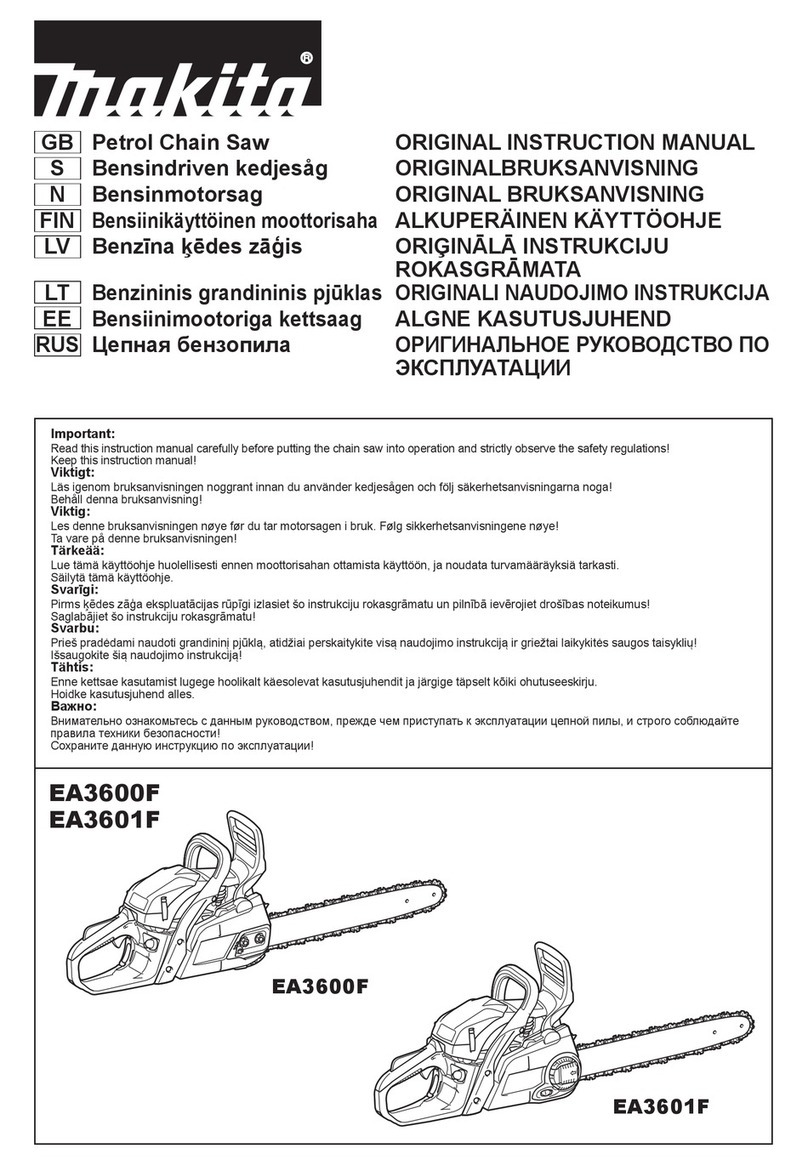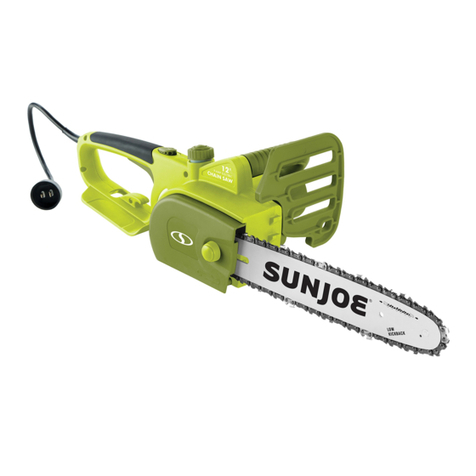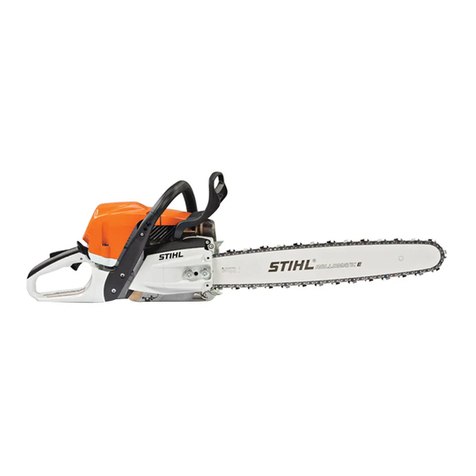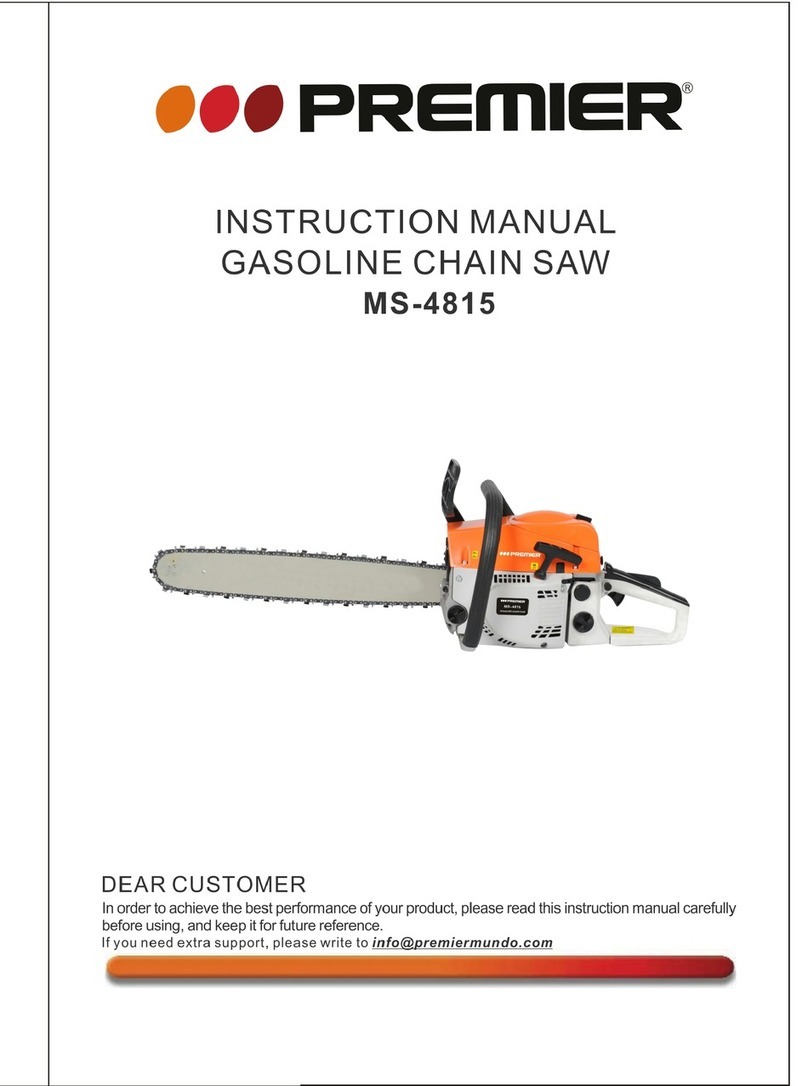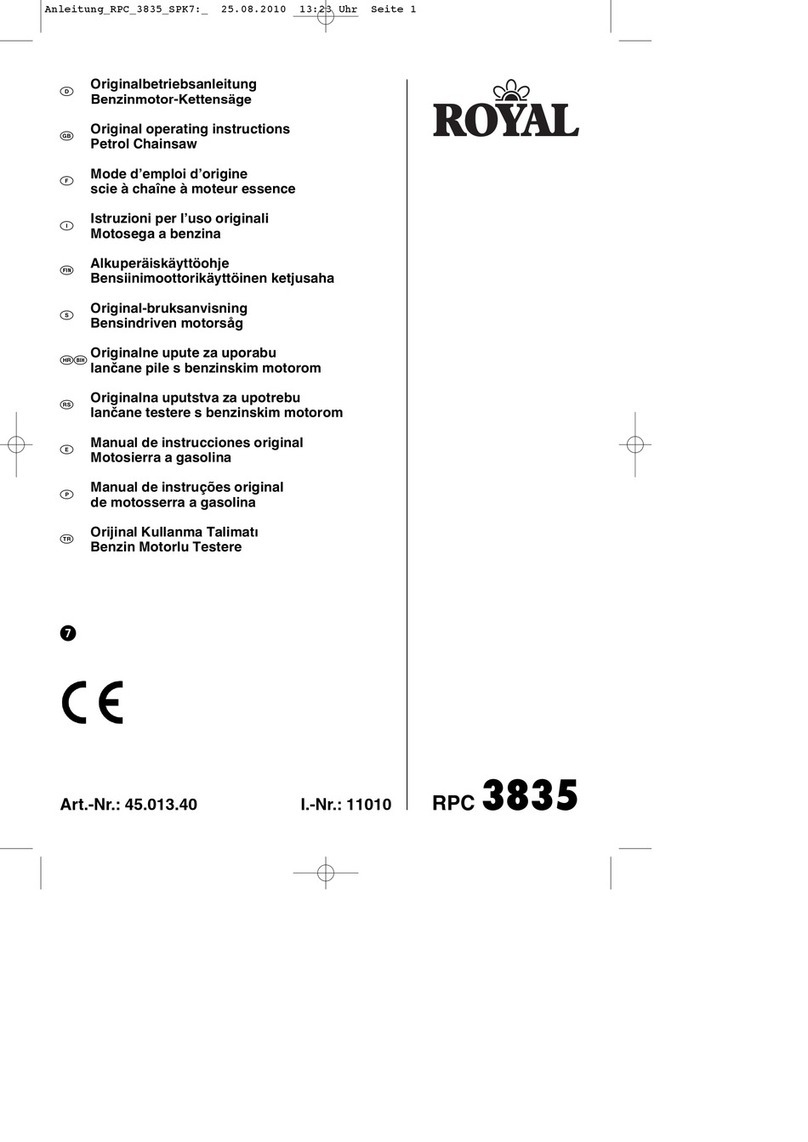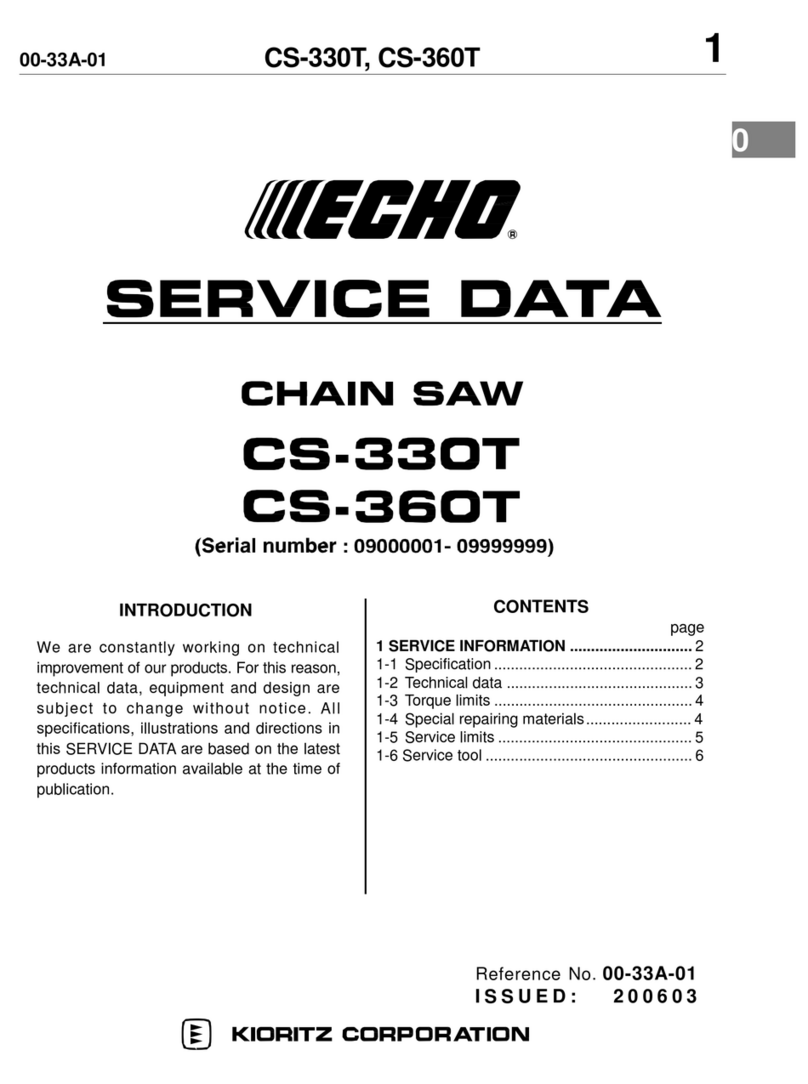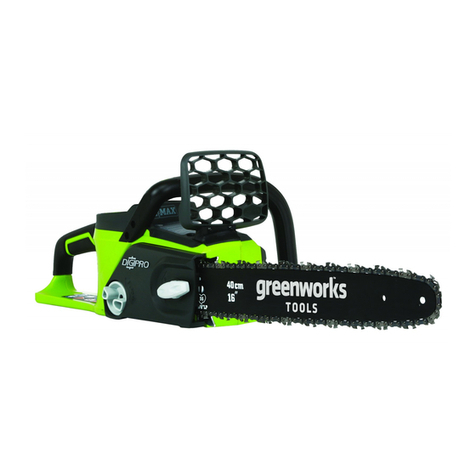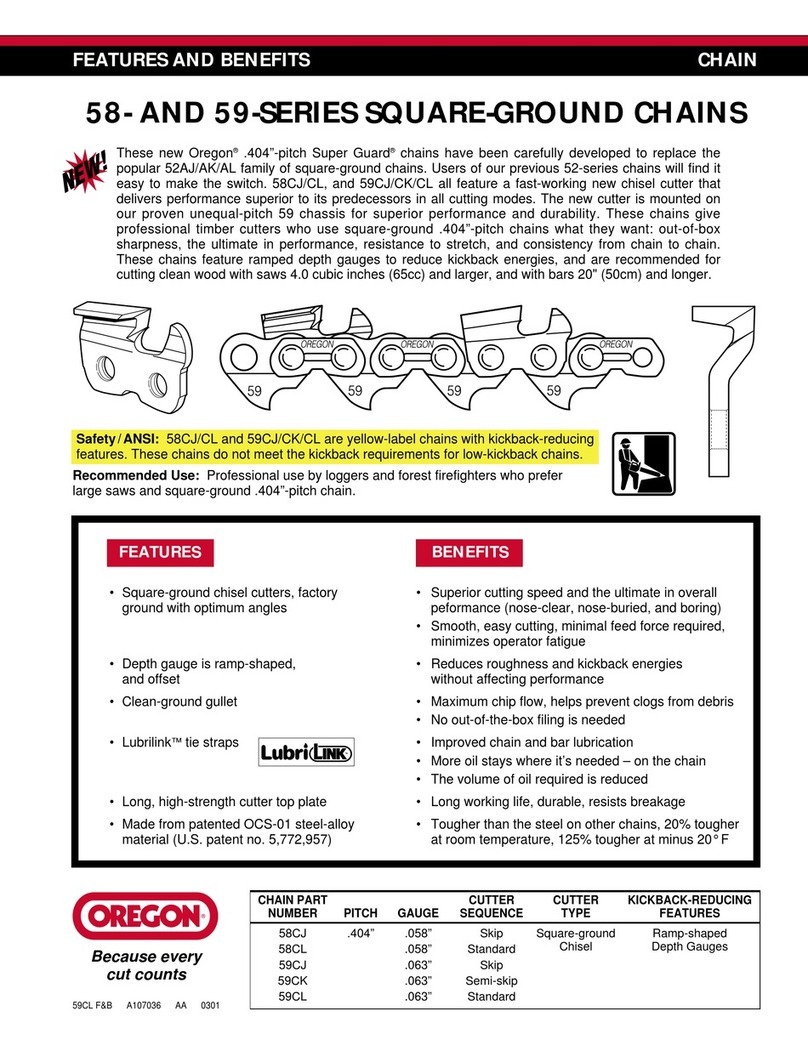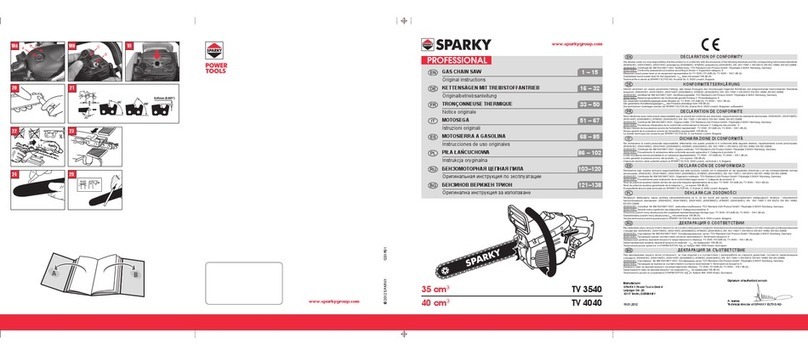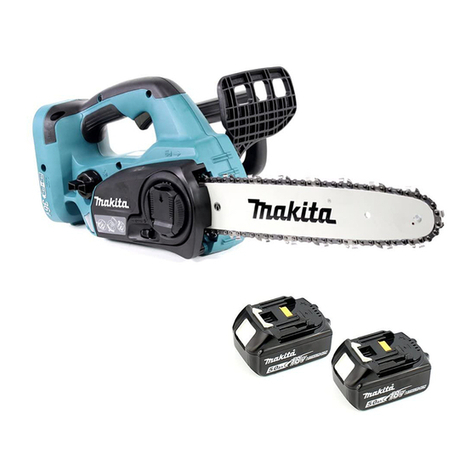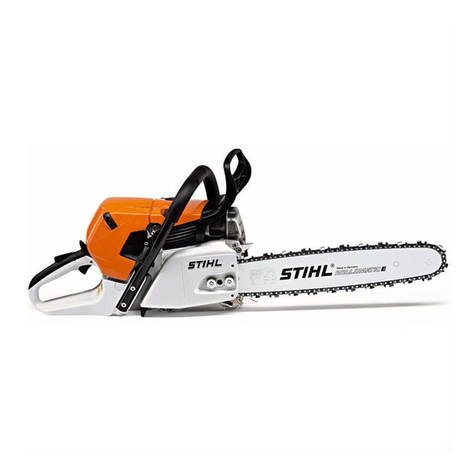Trueshopping SFCS00B4SA User manual

1
EN
Pg. 2
36V Lithium Brushless Chain Saw
DE
Pg. 22
Akku-Kettensäge 36V Li-Ion 4AH
FR
Pg. 39
Tronçonneuse sans fil 36V Li-Ion 4AH
IT
Pg. 56
Motosega Elettrica con Batteria al Litio da 36V
ES
Pg. 72
Motosierra sin Escobillas con Batería de Litio de 36V

2
Product Appearance and Names of All Parts:
1. Guide Bar 5. Lithium Battery Pack Knob 10. Oil Tank Cap
2. Saw Chain 6. Lock Off Button Ring 11. Front Handle
3. Bumper 7. Rear Handle 12. Side Cover Lock Knob
4. Chain Kickback 8. Trigger 13. Chain Tensioning
Brake Handle 9. Oil Inspection Window Ring
ENGLISH
Warning: For your safety, please pay attention to
the following before starting:
•Please read and understand the Manual.
•DO not lend your product to someone without
instructions.
Warning! Some dust created by power
cutting contains chemicals known to the
state of California to cause cancer, birth
defects or other reproductive harm. Some
examples of these chemicals are:
•Lead from lead-based paints
•Crystalline silica from bricks and cement and
other masonry products
•Arsenic and chromium from chemically-
treated lumber.
Your risk from these exposures varies, depending
on how often you do this type of work. To reduce
your exposure to these chemicals: work in a well-
ventilated area, and work with approved safety
equipment, such as those dust masks that are
specially designed to filter Out microscopic
particles.
Warning! Be sure to read and
understand all safety instructions in this
Operator's Manual, including all safety
alert symbols such as "DANGER," "WARNING," and
"CAUTION" before using this tool. Failure to
following all instructions listed below may result in
electric shock, fire, and/or serious personal injury.

3
Warning Symbol
The user manual and product
contain the following symbols:
Warning! When using the Pole Hedge
Trimmer, negligence or improper use
may cause serious or fatal injury. It is
extremely important to read and
understand the contents of this
operating manual.
Please read this manual carefully and
ensure use of the machine only after
fully understanding all instructions.
Be sure to wear:
• Qualified hearing protection
equipment.
• Qualified eye protection equipment
Be sure to wear the qualified protective
gloves
Wear an approved safety hard hat to
protect your head.
Contact of the guide bar tip with any
object should be avoided
Tip contact can cause the guide bar to
move suddenly upward and backward,
which can cause serious injury.
Always use two hands when operating
the chain saw
This product uses lithium-ion (Li-
ion) batteries. Local, state, or
federal laws may prohibit disposal
of batteries in ordinary trash. Consult your local
waste authority for information regarding
available recycling and/or disposal options.
IPX4
Protection from splashing
water
V
Voltage
A
Current
Hz
Frequency (cycles per
second)
W
Power
min
Tlme
Type of current
Type or a characteristic of
current
no
Rotational speed, at no
load
.../min
Revolutions per minute
For other symbols/identifications on the
machine, refer to the special certification
requirements for specific markets.
DANGER: People with electronic
devices, such as pacemakers,
should consult their physician(s)
before using this product.
Operation of electrical equipment
in close proximity to a heart pacemaker could
cause interference or failure of the pacemaker.

4
General Power Tool Safety
Warnings
WARNING! Read all safety warnings and
instructions. Failure to follow the warnings and
instructions may result in electric shock, fire
and/or serious injury.
Save all warnings and instructions for future
reference.
The term "power tool" in the warnings refers to
your mains-operated (corded) power tool or
battery-operated (cordless) power tool.
Work Area Safety
•Keep work area clean and well lit. Cluttered or
dark areas invite accidents.
•Do not operate power tools in explosive
atmospheres, such as in the presence of
flammable liquids, gases or dust. Power tools
create sparks which may ignite the dust or
fumes.
•Keep children and bystanders away while
operating a power tool. Distractions can cause
you to lose control.
Electrical Safety
•Power tool plugs must match the outlet.
Never modify the plug in any way. Do not use
any adaptor plugs with earthed (grounded)
power tools. Unmodified plugs and matching
outlets will reduce risk of electric shock
•Avoid body contact with earthed or grounded
surfaces, such as pipes, radiators, ranges and
refrigerators. There is an increased risk of
electric shock if your body is earthed or
grounded.
•Do not expose power tools to rain or wet
conditions. Water entering a power tool will
increase the risk of electric shock.
•Do not abuse the cord. Never use the cord for
carrying, pulling or unplugging the power tool.
Keep cord away from heat, oil, sharp edges or
moving parts. Damaged or entangled cords
increase the risk of electric shock.
•When operating a power tool outdoors, use
an extension cord suitable for outdoor use.
Use of a cord suitable for outdoor use reduces
the risk of electric shock.
•If operating a powertool in a damp location is
unavoidable, use a Ground-fault circuit
interrupter protected supply. Use of GFCI
reduces the risk of electric shock.
Personal Safety
•Stay alert, watch what you are doing and use
common sense when operating a power tool.
Do not use a power tool while you are tired or
under the influence of drugs, alcohol, or
medication. A moment of inattention while
operating power tools may result in serious
personal injury.
•Use personal protective equipment. Always
wear eye protection. Protective equipment
such as dust mask, non-skid safety shoes,
hard hat, or hearing protection used for
appropriate conditions will reduce personal
Injuries.
•Prevent unintentional starting. Ensure that
the switch is in the offposition before
connecting to power source and/or battery
pack, picking up or carrying the tool.
Carrying power tools with your finger on the
switch or energizing power tools that have the
switch on invites accidents.
•Remove any adjusting key or wrench before
turning the power tool on. A wrench or a key
left attached to a rotating part of the power
tool may result in personal injury.
•Do not overreach. Always Keep proper
footing and balance. This enables better
control ofthe power tool in unexpected
situations.
•Dress properly. Do not wear loose clothing or
jewelry. Keep your hair, clothing and gloves
away from moving parts. Loose clothes,
jewelry or bng hair can be caught in moving
parts.
•If devices are provided for the connection of
dust extraction and collection facilities,
ensure that these are connected and properly
used. Use of dust devices can reduce dust-
related hazards.
Power Tool Use and Care
•Do not force the power tool. Use the correct
power tool for your application. The correct
power tool will do the job better and safer at
the rate for which it was designed.
•Do not use the power tool if the switch does
not tum it on and off. Any power tool that
cannot be controlled with the switch is
dangerous and must be repaired.
•Disconnect the plug from the power source
and/or the battery pack from the power tool
before making any adjustments, changing
accessories, or storing power tools. Such
preventive safety measures reduce the risk Of
starting the power tool accidentally.
•Store idle power tools out ofthe reach of
children and do not allow persons unfamiliar
with the power tool or these instructions to
operate the power tool. Power tools are
dangerous in the hands of untrained users.

5
•Maintain power tools. Check for
misalignment or binding of moving parts,
breakage of parts and any other condition
that may affect the power tool’s
operation. If damaged, have the power
tool repaired before use. Many accidents
are caused by poorly maintained power
tools.
•Keep cutting tools sharp and clean. Properly
maintained cutting tools with sharp cutting
edges are less likely to bind and are easier to
control.
•Use the Power tool, accessories and told bits,
etc. in accordance to with these instructions,
taking into account the working conditions
and the work to be performed. Use of the
power tool for operations different from those
intended could result in a hazardous situation.
Battery Tool Use and Care
•Recharge only with the charger specified by
the manufacturer. A charger that is suitable
for one type of battery pack may create a risk
of fire when used with another battery pack.
•Use power tools only with specifically
designated battery packs. Use of any other
battery packs may create risk of injury and fire.
•When the battery pack is not in use, keep it
away from other metal objects, like paper
clips, coins, keys, nails, screws and other small
metal objects that can make connection from
one terminal to another. Shorting the battery
terminals together may cause burns or a fire.
•Under abusive conditions, liquid may be
ejected from the battery; avoid contact. If
contact accidentally occurs, flush with water.
If liquid contacts eyes, additionally seek
medical help. Liquid ejected from the battery
may cause irritation or burns.
Service
•Have your power tool serviced by a qualified
repair person using only identical replacement
parts This will ensure that the safety of the
power tool is maintained.
Chain Saw Safety Warnings
•Keep all parts of the body away from the saw
chain when the chain saw is operating. Before
you start the chains saw, make sure that the
chain saw is not contacting anything. A
moment of inattention whilst operating chain
saws may cause entanglement of your
clothing or body with the chain.
•Always hold the chain saw with your right
hand on the rear handle and your left hand on
the front handle. Holding the chain saw with a
reversed hand configuration increases the risk
of personal injury and should never be done.
•Hold the power tool by insulated gripping
surfaces only, because the saw chain may
contact hidden wiring. Saw chains contacting
a live wire may make exposed metal parts of
the power tool live and could give the
operator a shock.
•Wear safety glasses and hearing protection.
Further protective equipment for head, legs,
hands and feet is recommended. Adequate
protective clothing will reduce personal injury
by flying debris or accidental contact with the
chain saw
•Do no operate a chain saw in a tree. Operation
of a chain saw while up in a tree may result in
personal injury.
•Always keep proper footing and operate the
chain saw only when standing on fixed, secure
and level surface. Slippery and unstable
surfaces such as ladders may cause a loss of
balance or control of the chain saw.
•When cutting a limb that is under tension be
alert for spring back. When the tension of the
wood fibres is released the spring-loaded limb
may strike the operator and/or throw the
chain saw out of control.
•Use extreme caution when cutting brush or
saplings. The slender material may catch the
saw chain and be whipped towards you or pull
you off balance.
•Carry the chain saw by the front handle when
switched off and away from your body. When
transporting or storing the chain saw always
fir the guide bar cover. Proper handling of the
chain saw will reduce the likelihood of
accidental contact with the moving saw chain.
•Follow instructions for lubricating, chain
tensioning and changing accessories.
Improperly tensioned or lubricated chain may
either break or increase chance for kickback.
•Keep handles, dry, clean and free from oil and
grease. Greasy, oily handles are slippery and
cause loss of control.
•Cut wood only. Do not use chain saw for
purposes not intended. For example; do not
use chain saw for cutting plastic, masonry or
non-wood building materials. Use of the chain
saw for operations different than intended
could result in a hazardous situation.

6
Causes and Operator Prevention of
Kickback - (Fig. 1, 2, 3 & 4)
•Kickback may occur when the nose or tip of the
guide bar touches an object, or when the wood
closes in and pinches the saw chain in the cut.
•Tip contact in some cases may cause a
sudden reverse reaction, kicking the guide
bar up and back towards the operator.
•Pinching the saw chain along the top ofthe
guide bar may push the guide bar rapidly back
towards the operator.
•Either ofthese reactions may cause you to
lose control of the saw, which could result
in serious personal injury. Do not rely
exclusively upon the safety devices built
into your saw.
•As a chain saw user, you should take several
steps to keep your cutting jobs free from
accident or injury.
•Kickback is the result oftool misuse and/or
incorrect operating procedures or conditions
and can be avoided by taking proper
precautions as given below:
•Maintain a firm grip, with thumbs and fingers
encircling the chain saw handles, with both
hands on the saw and position your body and
arm to allow you to resist kickback forces (Fig.
4). Klckback forces can be controlled by the
operator, if proper precautions are taken. Do
not let go of the chain saw.
•Do not overreach and do not cut above
shoulder height. This helps prevent
unintended tip contact and enables better
control of the chain saw in unexpected
situations.
•Only use replacement bars and chains
specified by the manufacturer, Incorrect
replacement bars and chains may Cause chain
breakage and/or kickback
•Follow the manufactureds sharpening and
maintenance instructions for the saw chain.
Decreasing the depth gauge height can lead to
increased kickback.
•Make sure that the area in which you are
cutting is free from obstructions. Do not let
the nose of the guide bar contact a log,
branch, fence, or any other obstruction that
could be hit while you are operating the saw.

7
•Always cut with the unit running at full speed.
Fully squeeze the switch trigger and maintain
cutting speed.
•With a basic understanding of kickback, you
can reduce or eliminate the element of
surprise. Sudden surprise contributes to
accidents.
•Always keep proper footing and balance. Push
and Pull - The reaction force is always opposite
to the direction the chain is moving where
wood contact is made. Thus, the operator
must be ready to control the PULL when
cutting on the bottom edge of the bar, and the
PUSH when cutting along the top edge. See
Figure 5.x
Additional Warnings
•A chain saw is intended for twohanded use.
Serious injury to the operator, helpers, and/or
bystanders can result from one-handed
operation.
•Avoid unintentional contact with the
stationary saw chain or guide bar rails. These
can be very sharp. Always wear gloves and
long pants or chaps when handling the chain
saw, saw chain, or guide bar.
•Never operate a chain saw that is damaged or
improperly adjusted or that is not completely
and securely assembled. Be sure that the saw
chain stops moving when the trigger switch is
released.
•Inspect the work piece for nails, wire, or other
foreign objects prior to cutting.
•When bucking, secure the work piece prior to
cutting. When felling or pruning, identify and
secure hazardous branches.
•Aggressive or abusive cutting or misuse of the
chain saw can cause premature bar, chain,
and/or sprocket wear, as well as a broken
chain or bar, leading to kickback, chain throw
or the ejection of material.
•Never use the guide bar as a lever. A bent
guide bar Can cause premature bar, chain,
and/or sprocket wear, as well as a broken
chain or bar, leading to kickback, chain throw
or the ejection of material.
•Cut only one work piece at a time.
•Use only with Worth L811A or 1811B battery
pack
•Do not charge the battery pack in rain or in wet
locations.
•Plan the work, ensuring an obstacle-free work
area and, in the case of felling, at least one
escape path from the falling tree.
•When felling, keep bystanders at least two
tree lengths away.
•If situations occur which are not covered in
this manual, use care and good judgment.
Contact EGO Customer Service for assistance.
Kickback Safety Devices On This
Chain Saw
Chain Brake
The chain saw comes equipped with a chain
brake, which stops both the motor and the
motion of the chain when kickback occurs.
The chain brake can be activated by the
forward motion of the chain kickback brake
handle as the saw rotates backward during
kickback; it can also be activated by the
inertial forces generated during rapid
pushback.
Warning! Never modify or attempt
to disable the chain brake. Make sure
that the chain brake is working
properly before using the chain saw.
The chain kickback brake handle
should move back and forth easily.

8
To test the operation of the chain brake, perform
the following steps (Fig. 6):
•Place the chain saw on a fiat bare surface and
make sure no objects or obstructions that
could come in contact with the bar and chain
are in the immediate vicinity.
•Disengage the chain brake by pulling the chain
kickback brake handle towards the front
handle.
•Start the chain saw.
•Push the chain kickback brake handle towards
the front of the saw. A properly functioning
hand brake will stop the movement of the
chain immediately. If the chain brake is not
working properly, do not use the chain saw
until it has been repaired by a qualified service
technician.
Warning! Confirm that the chain
brake works properly before each
use.
If the chain brake is clogged with
wood chips, the function of the chain brake may
deteriorate. Always keep the device clean.
Low Kickback Saw Chain
The rakers (depth gauges) ahead of each cutter
can minimize the force of a kickback reaction by
preventing the cutters from digging in too deeply
at the kickback zone. Only use a replacement
chain that is equivalent to the original chain or has
been certified as a bw kickback chain per ANSI Bl
75.1. A low kickback tooth saw chain is a chain
that has met the kickback performance
requirements of ANSI 8175.1 (American National
Standard for Power Tools - Gasoline-Powered
Chain Saws-Safety Requirements) when tested on
the representative sample of chain saws below
3.8 cid. specified in ANSI Bl 75.1.
CAUTION: As saw chains are
sharpened during their useful life,
they lose some of the low kickback
qualities and extra caution should be
used.
Guide Bar
This saw comes equipped with a guide bar that
has a small radius nose. Small radius noses
generally have less potential for kickback. When
replacing the guide bar, be sure to order the bar
listed in this manual.
SAVE THESE INSTRUCTIONS!
Add the guide bar and apply the
saw chain lubricant
1. Remove the battery pack from the chain saw.
2. Clean the dust from the oil pot cover and the
surroundings to prevent dust from entering
the Oil tank when filling the oil.
3. Place the chain saw on the horizontal surface
and unscrew the oil pot cover counter-
clockwise.
4. Fill the lubricant in the oil pot up to the neck of
the oil
5. Close the oil pot cover and tighten it clockwise.

9
Insertion and removal of the
battery pack
1. According to the steps shown in Figure10,
align the two slots on the battery pack with the
two guide rails in the battery compartment (be
careful not to insert it reversely), and insert
the battery pack into the end until you hear
the clicking sound, indicating that the battery
pack is installed in place (Figure11).
2. Press and hold the battery pack release button
as shown in Figure 12. so that the battery pack
will pop up from the battery compartment and
remove the battery pack.
Tool and battery pack protection
system
•The tool is equipped with a tool and battery
pack protection system, which can
automatically cut off the motor power to
extend the life of the tool and the battery
pack.
•When used, the tool will automatically stop
running if the tool or battery pack is in the
following cases; in some cases, the battery
pack indicator light will illuminate or the
buzzer on the tool will sound.
Overload protection
•When the tool is operated in a manner that
results in an abnormally high current, the tool
will automatically stop running without any
indication. In this case, turn off the tool, stop
the operation that caused the overload of the
tool and then re-start the tool.
Battery pack over-temperature
protection
•When the temperature of the battery pack is
too high, the tool will automatically stop
working, and three indicator lights on the
battery pack will flash 5 times continuously at
the same time. At this point, the tool will not
start even if the trigger switch is turned on; in
this case, please start the tool after the battery
pack has cooled or replace the other battery
pack at the normal temperature and restart
the tool.
Tool over-temperature protection
•When the temperature of the tool is too high,
the tool will automatically stop working and
the buzzer on the tool will sound an alarm. At
this point, the tool will not start even if the
trigger switch is turned on; when this happens,
please start the tool after the tool is cooled.

10
Battery pack over-discharge
protection
•When the remaining capacity of the battery
pack becomes lower, the tool will
automatically stop working, and an indicator
light on the battery pack will flash 5 times (as
shown below); in this case, please charge the
battery
Start of chain saw
1. Insert the battery pack
2. Make sure that there are no obstructions in
contact with the guide bar and the chain
3. According to the steps shown in Figure 3, pull
the brake baffle toward the battery pack
(Figure 13) and ensure that it remains in the
working position.
4. Hold the front handle with you left hand, and
hold the rear handle with your right hand
5. Push forward the lock-off button and hold the
trigger switch so that the chain saw is started
(Figure 14).
Shutdown of chain saw
1. Remove the chain saw from the cutting
area, release the trigger switch and stop
the chain saw.
2. Push the brake baffe forward to switch it
to the braking position.
Preparation for Cutting
Refer to "Important Safety Instructions" earlier in
this manual for appropriate safety equipment
Work Area Precautions
•Cut only wood or materials made from wood;
do not cut sheet metal, plastics, masonry, or
non-wood building materials.
•Never allow children to operate the chain saw.
•Allow no person to use this chain saw who has
not read this Operators Manual or received
adequate instructions for the safe and proper
use of this chain
•When felling a tree, keep everyone - helpers,
bystanders, children, and animals - a safe
distance from the cutting area. During felling
operations, the safe distance should be a least
twice the height of the largest trees in the
felling area, during bucking operations, keep a
minimum distance of 15 feet (4.5 m) between
workers. Trees should not be felled in a
manner that would endanger any person,
strike any utility line or cause any property
damage. If a tree does make contact with any
utility line, stay clear of the tree and the line
and notify the utility company immediately.
•Always cut with both feet on solid ground to
prevent being pulled off balance.
•Do not cut above chest height, asa saw held
higher is difficult to control against kickback
forces.
•Do not fell trees near electrical wires or
buildings.
•Cut only when visibility and light are adequate
for you to see clearly.
Proper Grip on Handles
•Wear non-slip gloves for maximum grip and
protection.
•With the saw on a firm, fiat surface, hold the
saw firmly with both hands.
•Always grasp the front handle with the left
hand and the rear handle with the right
handle.
•The fingers should encircle the handle, with
the thumb wrapped under the front handle
(Figure 15).

11
Warning! Never se a left handed
(cross-handed) grip, or any stance
which would place your body or arm
across the chain line.
Warning! Do no operate the trigger
switch with you left hand hold the
front with your right hand. Never
allow any part of your body to be in
the chain line while operating a chain
saw (Figure 16)
Proper Cutting Stance (Figure 17)
•Both feet should be on solid ground, with
weight evenly spread between them.
•The left arm should be straight, with the elbow
locked. This helps to withstand the forces
generated by kickback.
•Your body should always be to the left of the
chain line.
Cutting
Basic Cutting
Warning! Always be sure of your
footing and hold the chain saw firmly
with both hands while the motor is
running.
Practice cutting a few small logs using the
following technique to get the 'feel" of using your
saw before you begin a major sawing operation.
1. Take the proper stance in front of the
wood with the saw off.
2. Press the lock-off button and squeeze the
trigger to start the chain saw. Let thechain
reach the full speed before beginning the
cut.
3. Begin cutting by lightly pressing the guide
bar against the wood. Use only light
pressure, letting the saw do the work
4. Maintain a steady speed throughout the
cut, releasing pressure just before the end
of the Cut.
5. Release the trigger as soon as the Cut is
completed, allowing the chain to stop.
Warning! Do not pull the saw chain
with your hand when it is bound by
the sawdust. Serious injury could
result if the chain saw starts
accidentally. Press the saw chain
against the wood, move the chain saw back and
forth to discharge the debris. Always remove the
battery pack before cleaning. Wear heavy
protective gloves when handling the saw chain.
Warning! Never start the chain saw
when it is in contact with the wood.
Always allow the chain saw reach full
speed before applying the saw to the
wood.

12
Felling a Tree
Hazardous Conditions
Warning! When felling a tree, it is
important that you heed the
following warnings to prevent
possible serious injury.
•Do not fell trees during periods of high wind or
heavy precipitation. Wait until the hazardous
weather has ended,
•Do not fell trees that lean at extreme angles or
large trees with rotten limbs, loose bark. or
hollow trunks. Instead, have these trees
pushed or dragged down with heavy
equipment and then cut them up.
•Do not fell trees near electrical wires or
buildings.
•Check the tree for damaged or dead branches
that could fall and hit you during felling.
•Periodically glance at the top of the tree during
the back cut to assure the tree is going to fall
in the desired direction.
•If the tree starts to fall in the wrong direction,
or if the saw gets caught or hung up during the
fall, leave the saw and save yourself!
Preparation for Tree Felling
•When bucking and felling operations are being
performed by two or more persons at the same
time, the felling operation should be separated
from the bucking operation by a distance of at
least twice the height of the tree being felled.
Trees should not be felled in a manner that
would endanger any person, strike any utility
line or cause any property damage. If the tree
does make contact with any utility line, the
utility company should be notified
immediately.
•The chain saw operator should stand on the
uphill side of the terrain, as the tree is likely to
roll or slide downhill after it is felled.
•Before any cuts are started, pick your escape
route (or routes, in case the intended route is
blocked). Clear the immediate area around the
tree and make sure that there are no
obstructions in your planned paths of retreat.
Clear a path of safe retreat approximately 135o
from the planned line of fall. The retreat oath
should extend back and diagonally to the rear
of the expected line of fall. See Figure 18.
Before felling is started, consider the natural lean
of direction to judge which way the tree will fall.
Remove dirt, stones, loose bark, nails, staples and
wire from the tree where felling cuts are to be
made.
Notching undercut
Make the notch 1/3 the diameter of the tree,
perpendicular to the direction of fall, as illustrated
in Figure 19. Make the lower horizontal notching
cut first. This will help to avoid pinching of either
the saw chain or the guide bar when the second
notch is being made.
Notching undercut
1. Make the felling back cut at least 2 inches
(50.8mm) higher than the horizontal notching
cut (Fig 16.). Keep the felling back cut parallel
to the horizontal notching cut. Make the felling
back cut so that enough wood is left to act as a
hinge. The hinge wood keeps the tree from
twisting and falling in the wrong direction. Do
not cut through the hinge.
2. As the felling cut gets close to the hinge, the
tree Warning! Keep a clear cutting should begin
to fall. If there is any chance that the tree area.
Make sure that no objects can may not fall in
the desired direction or it may rock back
contact the guide bar nose and chain and bind

13
the saw chain, stop cutting before the felling
during cutting; this can cause kickback. back
cut is complete and use wedges of wood,
plastic or aluminium to open the cut and drop
the tree along the desired line of fall.
3. When the tree begins to fall, remove the chain
saw from the cut, stop the motor, put the chain
saw down, then use the retreat path planned.
Be alert for overhead limbs falling and watch
your footing.
Limbing
Limbing is removing branches from a fallen tree.
When limbing, leave larger limbs to support the
log off the ground. Remove the small limbs in one
cut as illustrated in Fig. 20. Branches under tension
should be cut from the bottom up to avoid binding
the chain saw.
Warning! There is an extreme danger
of kickback during the limbing
operation. Be extremely cautious and
avoid contacting the log or other
limbs with the tip of the guide bar.
Bucking a Log (Fig. 21):
Bucking is cutting a log into lengths. It is important
to make sure your footing is firm, and your weight
is evenly distributed on both feet. When possible,
the log should be raised and supported by the use
of limbs, logs or chocks. Follow the simple
directions for easy cutting.
Warning! Keep a clear-cutting area.
Make sure that no objects can contact
the guide bar nose and chain during
cutting; this can cause kickback.
Overbucking
Begin on the top side of the log with the bottom of
the saw against the log; exert light pressure
downward. Note that the saw will tend to pull
away from you.
Underbucking
Begin on the underside of the log with the top of
the saw against the log; exert light pressure
upward. During underbucking, the saw will tend to
push back at you. Be prepared for this reaction
and hold the saw firmly to maintain control.
•When the log is supported along itsentire
length, it should be cut from the top
(overbucking) (Fig. 22).
•When the log is supported on only one end, cut
1/3 the diameter from the underside
(underbucking). Then make the finishing cut by
overbucking to meet the first cut (Fig. 23).
•When the log is supported on both ends, cut
1/3 of that diameter from the top overbuck.
Then make the finished cut by underbucking
the lower 2/3 to meet the first cut (Fig. 24).

14
•When bucking on a slope, always stand on
the uphill side of the log (Fig. 25).
•To maintain complete control when
cutting through, release the cutting
pressure near the end of the cut without
relaxing the grip on the chain saw handles.
Don't allow the chain to contact the
ground. After completing the cut, wait for
the saw chain to stop before you move the
chain saw. Always stop the motor before
moving from tree to tree.
Maintenance
Warning! When servicing, use only
identical replacement parts. Use of
any other parts may create a hazard
or cause product damage.
Warning! Always wear safety goggles
or safety glasses with side shields
during power tool operation or when
blowing dust. If the operation is dusty,
also wear a dust mask.
Warning! To avoid serious personal
injury, remove the battery pack from
the chain saw before inspecting,
cleaning, or performing maintenance.
A battery operated tool with the
battery pack inserted is always on and can start
accidently.
Warning! When cleaning the chain
saw, DO NOT immerse in water or
other liquids.
Warning! Do not at any time let
brake fluids, gasoline, petroleum-
based products, penetrating oils, etc,
come in contact with plastic parts.
Chemicals can damage, weaken, or
destroy plastic, which may result in serious
personal injury.
Cleaning
•After each use, clean debris from the chain and
guide bar with a soft brush. WIpe the chain saw
surface with a clean cloth moistened with a
mild soap solution.
•Remove the side cover, and then use a soft
brush to remove debris from the guide bar, saw
chain, sprocket and side cover.
•Always clean out wood chips, saw dust, and dirt
from the guide bar groove when replacing the
saw chain.

15
Replacing the saw chain and guide
plate
1. Remove the battery pack from the chainsaw.
2. Release the guide plate locking knob counter
clockwise and open the side cover according to
the steps as shown in Figure 26.
3. Rotate the disk wheel at the rear end of the
guide plate counter-clockwise and remove the
guide bar and the saw chain.
4. According to the steps shown in Figure 27,
install the saw chain in the guide slot on the
guide abr. Note that the direction of the saw
chain is the same as the direction indicated on
the guide bar (Figure 28).
5. Grasp the guide bar and the saw chain so that
the centre hole of the disk wheel is inserted
into the screw stud, and lop the saw chain onto
the sprocket (Figure 29)
6. Cover the side cover and tight the side cover
lock knob properly but do not make it too tight.
7. Rotate the chain tensioning ring clockwise until
the saw chain is tight enough (see the
description of the chainsaw tension
adjustment section).
8. Tighten the side cover lock knob.
Adjusting the Chain Tension
1. Stop the motor and remove the battery pack
before adjusting the chain tension.
2. Loosen the side cover knob.
3. Turn the chain-tensioning knob clockwise to
tension the chain. See the section:
"REPLACING THE BAR AND CHAIN" in this
manual for additional information.
•A cold chain is correctly tensioned when there
is no slack on the underside of the guide bar
and the chain is snug, but it can be turned by
hand without binding. The chain must be re-
tensioned whenever the flats on the drive links
do not sit in the bar groove.
•During normal saw operation, the temperature
ofthe chain will increase. The drive links of a
correctly tensioned warm chain will hang
approximately 0.050 in. (1.3 mm) Out Of the
bar groove (Fig. 31).

16
NOTICE: New chains tend to stretch;
check chain tension frequently and
tension as required.
NOTICE: A chain tensioned while it is
warm may be too tight upon cooling.
Check the cold tension before next
use.
Chain Maintenance
WARNING: Remove the battery pack
before performing any maintenance;
failure to heed this warning could
result in serious personal injury.
WARNING: Always wear gloves when
handling the saw chain; these
components are sharp and may
contain burrs.
Use only low-kickback chains on this saw. This fast
cutting chain will provide kickback reduction when
properly maintained.
A properly sharpened saw chain cuts through
wood effortlessly, even with very little pressure.
Never use a dull or damaged saw chain. A dull saw
chain cutter leads to increased physical strain,
increased vibration load, unsatisfactory cutting
results and increased wear.
For smooth and fast cutting, the chain needs to be
maintained properly. The chain requires
sharpening when the wood chips are small and
powdery, the chain must be forced through the
wood during cutting, or the chain cuts to one side.
During maintenance of your chain, consider the
following:
•Improper filing angle of the side plate can
increase the risk of a severe kickback.
•Raker (depth gauge) clearance. TOO low
increases the potential for kickback. Not low
enough decreases cutting ability.
•If cutter teeth have hit hard objects, such as
nails and stones, or have been abraded by mud
or sand on the wood, have the chain sharpened
by a qualified service technician.
NOTICE: Inspect the drive sprocket
for wear or damage when replacing
the chain. If signs of wear or damage
are present in the areas indicated,
have the drive sprocket replaced by
qualified service technician.
How to Sharpen the Cutters
Be careful to file all cutters (Figure. 32) to the
specified angles and to the same length, as fast
cutting can be obtained only when all cutters are
uniform.
1. Remove the battery pack. Wear gloves for
protection.
2. Properly tension the chain prior to sharpening.
Refer to the section “ADJUSTING THE CHAIN
TENSION” earlier in the manual.
3. Use a 0.177” (4.5mm) diameter round file and
holder (available separately). Do all your filing
at the middle of the guide bar.
4. Keep the file level with the top plate of the
tooth. Do not let the file dip or rock.
5. Keep a correct sharpening angle of 30o
between the file and saw the chain; see Figure
33 and 34. Always use a file folder (available
separately) when sharpening saw chains by
hand. File holders have markings for
sharpening angle.
6. Using light but firm pressure, stroke towards
the front corner of the tooth. Lift the file from
the steel on each return stroke.
7. Make a few frim strokes on every tooth. File all
left hand cutters in one direction. Then move
to the opposite side and file the right-hand
cutters in the opposite direction. Occasionally
remove filings from the file with a wire brush
(Figure 35).

17
WARNING: A dull or improperly
sharpened chain can cause excessive
motor speed during cutting, which may
result in severe motor damage.
WARNING: Improper chain
sharpening increases the potential of
kickback.
WARNING: Failure to replace or
repair a damaged chain can cause
serious injury.
Top Plate Sharpening Angles (Fig.
36)
•CORRECT 30o- This optimal angle can be
obtained only when the specified files and
proper setting are used. File holders are
marked with guide marks to align the file
properly to produce the correct top plate
angle.
•LESS THAN 30o- The tooth is too dull for cutting.
•MORE THAN 30o- The edge Ofthe cutting tooth
is feathered and dulls quickly.
Side Plate Angle (Figure 37)
•CORRECT 55'- The optimal angle can be
produced automatically if the correct diameter
file is used in the file holder.
•HOOK- "Grabs" and dulls quickly. Increases
potential of KICKBACK. Results from using a file
with a diameter that is too small, or a file held
too low.
•BACKWARD SLOPE- Needs too much feed
pressure, causes excessive wear to bar and
chain. Results from using a file with a diameter
too large, or a file held too high.

18
Depth Gauge Clearance
1. The depth gauge should be maintained at a
clearance of 0.025 in. (06 mm), as shown in Fig.
38. Use a depth gauge tool (available
separately) to check the depth gauge
clearances.
2. Check the depth gauge clearance every time
the chain is filed.
Use a fiat file and a depth-gauge jointer (both
available separately) to lower all gauges uniformly
(Fig. 39). Depth-gauge jointers are available in
0.020 in. to 0.035 in. (0.5 mm to 0.9 mm). Use a
0.025 in. (0.6 mm) depth-gauge jointer.
Depth-gauges must be adjusted with the fiat file in
the same direction the adjoining cutter was filed
with the round file. Use care not to contact the
cutter face with the flat file when adjusting depth-
gauges.
Guide Bar Maintenance
When the guide bar shows signs of wear, reverse it
on the saw to distribute the wear for maximum
bar life. The bar should be cleaned every day of
use and checked for wear and damage. Feathering
or burring of the bar rails is a normal process of
bar wear. Such faults should be smoothed with a
file as soon as they occur. A bar with any of the
following faults should be replaced.
•Wear inside the bar rails which permits the
chain to lay over sideways.
•Bent guide bar.
•Cracked or broken rails.
•Spread rails.
In addition, the guide bar has a sprocket at its tip.
The sprocket must be lubricated weekly with a
grease syringe to extend the guide bar life. Use a
grease syringe to lubricate weekly with chain oil by
means of the lubricating hole (Fig. 40). Turn the
guide bar and check that the lubrication holes and
chain groove are free from impurities.

19
Troubleshooting
WARNING: Always protect your hands by wearing heavy gloves when performing any
maintenance on the saw chain. Always remove the battery pack when servicing or transporting
the chain saw.
Problem
Cause
Solution
Motor does not
run.
•The battery pack is not attached to the
chain saw.
•There is no electrical contact between
the saw and battery.
•The battery pack is depleted.
•The battery pack or chain saw is too
hot.
•The back-off button is not depressed
before pressing the trigger switch.
•Chain brake is engaged.
•Saw chain is bound in the wood.
•Debris in bar groove.
•Debris inside cover.
•Attach the battery pack to the chainsaw.
•Remove the battery, check contacts and reinstall the
battery pack.
•Charge the battery pack.
•Allow the battery pack or chainsaw to cool.
•Press down the lock-off button and hold it, then
depress the trigger switch to turn on the chain saw.
•Pull the chain kickback brake handle backward
toward the front handle.
•Release the trigger switch; remove the saw chain and
guide bar from the wood, then restart the chain saw.
•Press the saw chain against the wood, move the
chain saw back and forth to discharge the debris.
•Remove battery pack, then remove side cover and
clean out debris.
Motor runs, but
chain does not
rotate.
• Chain does not engage drive sprocket.
• Reinstall the chain, making sure that the drive links on
the chain are fully seated on the sprocket.
Chain brake does
not engage.
• Debris preventing full movement of
the chain kickback brake handle.
• Clean debris from extremal chain brake mechanism.
Chain saw does
not cut properly.
•Insufficient chain tension.
•Dull chain.
•Chain installed backwards.
•Worm chain.
•Dry or excessively stretched chain.
•Chain not in bar groove
•Readjust the chain tension, following the section:
"ADJUSTING THE CHAIN TENSION".
•Sharpen the chain cutters, following the section:
"HOW TO SHARPEN THE CUTTERS".
•Reinstall the saw chain, following the section:
"REPLACING THE BAR AND CHAIN".
•Replace the chain, following the section: "REPLACING
THE BAR AND CHAIN".
•Check the oil level. Refill the oil tank if necessary.
•Reinstall the saw chain, following the section:
"REPLACING THE BAR AND CHAIN'.
Bar and chain
running hot and
smoking.
•Check chain tension for over tightened
condition.
•Chain oil tank is empty.
•Debris in guide bar groove.
•Re-tension the saw chain; seethe section: "ADJUSTING
THE CHAIN TENSION'.
•Filling bar and chain lubricant.
•Clear the debris in the groove.

20
Technical Parameters
Model No.
SFCS00B4SA
Max Voltage
DC 36V
Motor
Brushless Motor
No Load Speed
11500rpm
Chain Speed
21m/s
Bar Length
16” (406mm)
Chain pitch
3/8" (9.5mm)
Chain gauge
0.05” (1.1mm)
Max Cutting Length
395mrn
Locking knob & Chain
tensioning knob
Tool-less
Double Safety Brake
YES
Auto Lubricate
YES
Table of contents
Languages:
Other Trueshopping Chainsaw manuals

